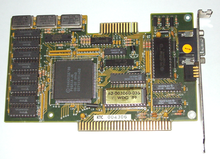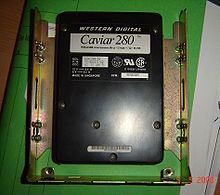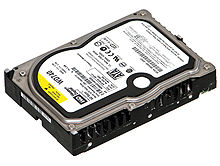- Western Digital
-
Western Digital Corporation 
Type Public (NYSE: WDC) Industry Computer hardware Founded April 23, 1970 Headquarters Irvine, California, United States Area served Worldwide Key people John F. Coyne (CEO)
Joseph R. Carrillo (Vice President/Controller/CAO)
Hossein Moghadam (CTO, SVP)
Thomas E. Pardun (Chairman)
Timothy M. Leyden (EVP, CFO)Products Hard disk drives Revenue  $9.850 billion (2010)
$9.850 billion (2010)Operating income  $1.525 billion (2010)
$1.525 billion (2010)Net income  $1.382 billion (2010)
$1.382 billion (2010)Total assets  $7.328 billion (2010)
$7.328 billion (2010)Total equity  $4.709 billion (2010)
$4.709 billion (2010)Employees  62,500 (2010)[1]
62,500 (2010)[1]Website WDC.com Western Digital Corporation (NYSE: WDC) (often abbreviated to WD) is one of the largest computer hard disk drive manufacturers in the world.[2] It has a long history in the electronics industry as an integrated circuit maker and a storage products company. Western Digital was founded on April 23, 1970 by Alvin B. Phillips, a Motorola employee, as General Digital, initially (and briefly) a manufacturer of MOS test equipment. It rapidly became a speciality semiconductor maker, with start-up capital provided by several individual investors and industrial giant Emerson Electric Company. Around July 1971 it adopted its current name and soon introduced its first product, the WD1402A UART.
Contents
History
1970s
Through the early years of the 1970s, WDC made their money by selling calculator chips; by 1975, they were the largest independent calculator chip maker in the world. The oil crisis of the mid-1970s and the bankruptcy of its biggest calculator customer, Bowmar Instrument,[3] changed its fortunes, however. In 1976, Western Digital declared Chapter 11 bankruptcy. After this, Emerson withdrew their support of the company, and WDC was on its own.
WDC introduced several landmark products during this time, including the MCP-1600 multi-chip, microcoded CPU. The MCP-1600 was used to implement DEC's LSI-11 system and their own Pascal MicroEngine microcomputer which ran the UCSD p-System Version III and UCSD Pascal. The processor was also used in several single-chip floppy disk drive controller chips, notably the FD1771.
1980s
The WD1771 and its kin were WDC's first entry into the data storage industry; by the early 1980s, they were making hard disk drive controllers, and in 1983, they won the contract to provide IBM with controllers for the PC/AT. That controller, the WD1003, became the basis of the ATA interface (which WDC developed along with Compaq and Control Data Corporation's MPI division, now owned by Seagate Technology), starting in 1986. Throughout most of the 1980s, the family of controllers based on the WD1003 provided the bulk of WDC's revenues and profits, and for a time generated enormous corporate growth.
Much of the mid-to-late 1980s saw an effort by WDC to use the profits from their ATA storage controllers to become a general-purpose OEM hardware supplier for the PC industry. As a result, WDC purchased a number of hardware companies. These included graphics cards (through their Paradise subsidiary, purchased 1986), core logic chipsets (by purchasing Faraday Electronics Inc. in 1987), SCSI controller chips for disk and tape devices (by purchasing ADSI in 1986), networking (WD8003, WD8013 Ethernet and WD8003S StarLAN). They did well (especially Paradise, which produced one of the best VGA cards of the era), but storage-related chips and disk controllers were their biggest money makers. In 1986, they introduced the WD33C93 single-chip SCSI interface, which was used in the first 16-bit bus mastering SCSI host adapter, the WD7000 "FASST"; in 1987 they introduced the WD37C65, a single-chip implementation of the PC/AT's floppy disk controller circuitry, and the grandfather of modern super I/O chips; in 1988 they introduced the WD42C22 "Vanilla", the first single-chip ATA hard disk controller.
1988 also brought what would be the biggest change in WDC's history. That year, WDC bought the hard drive production assets of PC hardware maker Tandon; the first products of that union under WDC's own name were the "Centaur" series of ATA and XT attachment drives.
1990s
By 1991, things were starting to slow down, as the PC industry moved from ST-506 and ESDI drives to ATA and SCSI, and thus were buying fewer hard disk controller boards. That year saw the rise of WDC's Caviar drives, brand new designs that used the latest in embedded servo and computerized diagnostic systems.
Eventually, Caviar drives were selling so well that WD started to dispose of its other divisions. Paradise was sold to Philips (and has since disappeared); their networking and floppy drive controller divisions went to SMC Networks; and their SCSI chip business went to market leader Adaptec. Around 1995 the technological lead that the Caviar drives had enjoyed was eclipsed by newer offerings from other companies, especially Quantum Corp., and WDC fell into a slump.
Products and ideas of this time didn't go far; the Portfolio drive (a 3-inch (76 mm) form factor model, developed with JT Storage) was a flop, as was the SDX hard disk to CD-ROM interface. WDC's drives started to slip further behind products by other makers, and quality began to suffer; system builders and PC enthusiasts who used to recommend WD above all else were going to the competition, particularly Maxtor, whose products had improved significantly by the late 1990s.
In an attempt to turn the tide in 1998, WD recruited the help of IBM. This agreement gave WD the rights to use certain IBM technologies, including giant magneto-resistive (GMR) heads, and access to IBM production facilities. The result was the Expert line of drives, introduced in early 1999. The idea worked, and WD regained much respect in the press and among users, even despite a recall in 2000 (which was due to bad motor driver chips). WDC has since broken ties to IBM.
2000s
In 2001, Western Digital became the first manufacturer to offer mainstream ATA hard disk drives with 8 MB (8 MiB) of cache buffer. At that time most desktop hard disk drives had 2 MB of buffer. WDC labeled these 8 MB models as "Special Edition" and distinguished them with the JB code (the 2 MB models had the BB code). The first 8 MB cache drive was the 100 GB WD1000JB; models with capacities from 40 GB to 250 GB and more followed. WD advertised the JB models as a good choice for cost-effective file servers.
In 2003, WD acquired most of the assets of bankrupt one-time market leading magnetic hard drive read-write head developer Read-Rite Corporation. In the same year, WD offered the first 10,000 rpm Serial ATA HDD: The WD360GD "Raptor" with a capacity of 36 GB and an average access time of less than 6 milliseconds. Soon, the 74 GB WD740GD, which is also much quieter, followed and in 2005 Western Digital released the 150 GB version, the WD1500. As of 2004[update] the WD Raptor drives have 5 years of warranty, making them a more attractive choice for inexpensive storage servers, where a large number of drives in constant use increases the likelihood of a drive failure. In 2006, Western Digital introduced its My Book line of mass market external hard drives that feature a compact book-like design. On the 7th October 2007 Western Digital released several editions of a single 1 TB hard drive - the largest in its My Book line.
In 2007, Western Digital acquired magnetic media maker Komag. Also in the same year, Western Digital adopted perpendicular recording technology in its line of notebook and desktop drives. This allowed it to produce notebook and desktop drives in the largest classes of the time. Western Digital also started to produce the energy efficient GP (Green Power)[4] range of drives notable for their very low power consumption and heat dissipation but surprisingly good performance.[5]
In 2007 Western Digital announced the WD GP drive touting rotational speed "between 7200 and 5400 rpm", which, if potentially misleading, is technically correct; the drive spins at 5405 rpm, and the Green Power spin speed is not variable.[citation needed]
On April 21, 2008, Western Digital announced the next generation of its 10,000 rpm SATA WD Raptor series of hard drives. The new drives, called WD VelociRaptor, feature 300 GB capacity and 2.5-inch (64 mm) platters enclosed in the IcePack, a 3.5-inch (89 mm) mounting frame with a built-in heat sink. Western Digital claims the new drives are 35 percent faster than the previous generation WD Raptors.
On September 12, 2008, Western Digital shipped a 500 GB 2.5-inch (64 mm) notebook hard drive which is part of their Scorpio Blue series of notebook hard drives.
On January 27, 2009, Western Digital shipped the first 2 TB internal hard disk drive.[6]
On March 30, 2009, WD entered the solid-state drive market with the acquisition of Siliconsystems, Inc.
On July 27, 2009, Western Digital announced the first 1 TB mobile hard disk drive, which shipped as both a Passport series portable USB drive as well as a Scorpio Blue series notebook drive.[7]
2010s
In October 2010, Western Digital announced the first 3 TB internal hard disk drive.
In March 2011, Western Digital has agreed to acquire the global storage unit of Hitachi, Hitachi Global Storage Technologies, for about $4.3 billion which $3.5 billion pay in cash and the rest with 25 million shares of Western Digital.[8]
On October 21, 2011, Western Digital's Thailand Plant suspended operation in relation to the 2011 Thailand floods. This has caused a shortage of Hard Drives supplied by Western Digital, and there may be restrictions on production from Seagate. PC manufacturers have been taking note of the issue with Apple CEO, Tim Cook stating that he was expecting an "an overall industry shortage of disk drives". A Dell spokesperson also stated that they were onto the issue and they were "working with our hard drive suppliers to address potential impact for the remainder of the year.”[9]
Warranty
Recently, WD sells many hard drives with a warranty of one, two, three or five years[10] included in the retail price, but it offers the customer the option of purchasing a longer (two- or three-year) warranty on its web site. Three years is the current industry standard and while Seagate Technology (a competitor) used to offer 5 years of warranty for all its drives, it recently moved back to a three-year warranty for its bulk (bare/OEM) consumer-level drives.[11]
High performance Raptor drives as well as the Caviar Black Series and RE Series still come with a five year warranty.[12]
Key innovations
Western Digital is responsible for a number of innovations, including
- c.1971 – WD1402A, the first single-chip UART
- c.1976 – WD1771, the first single-chip floppy disk controller
- 1981 – WD1010, the first single-chip ST-506 controller
- 1983 – WD1003 hard disk controller, predecessor to ATA
- 1986 – Co-developed ATA with Compaq and Control Data
- 1986 – WD33C93, one of the first SCSI interface chips
- 1987 – WD7000, first bus-mastering ISA SCSI controller
- 1987 – WD37C65, first single-chip PC/AT-compatible floppy disk controller
- 1988 – WD42C22, first single-chip ATA hard disk controller
- 1990 – Caviar drives introduced
- 2001 – the first mass market IDE drive with an 8 MB buffer
- 2003 – the first SATA drive running at 10,000 rpm
Locations
- North America: Canada - United States (Aliso Viejo, CA; Irvine, CA; Lake Forest, CA; Mountain View, CA; San Jose, CA; Fremont, CA; Longmont, CO; Belleair, FL; Pasadena, MD; Reading, MA; Bellevue, NE; Cleveland, OH; North Sioux City, SD; Austin, TX; Dallas, TX; Houston, TX)
- Europe: Prague (Czech Republic), Orsay (France), Dornach b. München (Germany), Leatherhead (UK), Schiphol (Amsterdam, NL)
- Asia: Beijing, Shanghai, Shenzhen, Hong Kong (China), Tokyo (Japan), Taipei (Taiwan), Seoul (S. Korea); Petaling Jaya, Penang, Johor Bahru (Malaysia); Singapore; Ayuthaya, Pathumthani (Thailand), Dubai (United Arab Emirates)
Software
Western Digital distributes the following utilities for use with its hard drives.
- Data Lifeguard Tools
- a software utility suite for basic setup of hard disks, developed under contract by Kroll Ontrack Inc (who also provides similar suites for other drive manufacturers). It runs on Microsoft Windows and DOS operating systems. It is free to download and use.
As of version 11 it contains the following features:
- displaying built-on-demand installation manuals (with jumper settings) for many Western Digital hard drives,
- partitioning and formatting hard disks,
- copying files between disk partitions,
- displaying numbers, size and type of partitions,
- displaying basic technical disk information, such as firmware revision, S.M.A.R.T Support (Enabled/Disabled), ATA # supported, R/W Multiple, PIO Mode Support, IORDY Support (Yes/No), Sectors/Block, PIO Cycle Time.
- Data Lifeguard Diagnostics
- is a software utility used primarily for determining the physical condition of the hard drive. It includes features such as:
- Quick and extended test
- Write zeros to drive
- View and print test results
- Enter and print return merchandise authorization (RMA) information
Western Digital also ships WD Smartware with many of its drives for use as backup drives. This software backs up all Documents, Pictures, Movies, Emails, and more on the drive, and continually checks for changes to drive locations. This means that regular backup takes place.
Consumer products
It also has launched two competitors in the over the top set top box market to compete with the Apple TV, Roku, and Google TV. See Western Digital Media Center for more info on its past and current lineup.
Lawsuits
- See also Binary prefix#Legal disputes
Lawsuits have been filed against hard disk manufacturers Seagate[15] and Western Digital,[16] related to the claimed capacity of their drives. The drives are labelled using the "decimal definition" of 1000 bytes to the kilobyte, resulting in a perceived capacity shortfall to those used to the "binary definition" of 1024 bytes to the kilobyte, which is how most operating systems report capacity.[17] While Western Digital maintained that they used "the indisputably correct industry standard for measuring and describing storage capacity", and that they "cannot be expected to reform the software industry", they agreed to settle in March 2006,[18] with a $30 refund to affected customers in the form of backup and recovery software of the same value.[17] A disclaimer is now included with all drives explaining the capacity figures.
See also
References
- ^ WD 2010 Proxy
- ^ Disk Drive Industry Update: Volume 76, Needham Company, June 14, 2011
- ^ Smith, William D. (February 11, 1975). "Bowmar Will Ask Reorganization". The New York Times: p. 55.
- ^ Western Digital - Biomedical Innovation with Colin Stewart - OCRegister.com
- ^ GreenPower Hard Drives
- ^ "Western Digital launches 2TB hard drive". ZDNet. 2009-01-27. http://news.zdnet.co.uk/hardware/0,1000000091,39603775,00.htm. Retrieved 2009-01-27.
- ^ "WD SHIPS INDUSTRY’S FIRST 1 TB MOBILE HARD DRIVE". WDC. 2009-07-27. http://www.westerndigital.com/en/company/releases/PressRelease.asp?release=89b24f84-a046-4511-9b61-e7e8b29d6785. Retrieved 2009-07-27.
- ^ http://www.businessweek.com/news/2011-03-08/hitachi-advances-on-4-3-billion-sale-to-western-digital.html
- ^ Bohn, Dieter. "Hard drive shortages and higher prices coming after massive flooding in Thailand". This is My Next. http://thisismynext.com/2011/10/22/world-hard-drive-shortage-predicted-floodi/. Retrieved 24 October 2011.
- ^ Warranty Policy and Limitations
- ^ Seagate to move from 5 to 3-year warranty. Fudzilla.com, 16 December 2008
- ^ WD Raptor X 150 GB SATA Hard Drives ( WD1500AHFD )
- ^ "Data Lifeguard Tools for Windows Version 11.2". Western Digital Support Downloads. http://support.wdc.com/product/download.asp?groupid=701&sid=1&lang=en. Retrieved 2008-11-06.
- ^ "Data Lifeguard Diagnostic for DOS (CD) Version 5.04f". Western Digital Support Downloads. http://support.wdc.com/product/download.asp?groupid=701&sid=30&lang=en. Retrieved 2008-11-06.
- ^ Seagate lawsuit concludes, settlement announced, bit-tech.net
- ^ Western Digital Settles Capacity Suit, betanews.com
- ^ a b Western Digital settles drive size lawsuit, arstechnica.com
- ^ NOTICE OF CLASS ACTION AND PROPOSED SETTLEMENT (“NOTICE”), wdc.com
- "Years of Innovation: The History of Western Digital" (pdf). Western Digital. Archived from the original on 1997-11-10. http://web.archive.org/web/19971110160457/www.wdc.com/acrobat/25thbroc.pdf.
- Great Microprocessors of the Past and Present by John Bayko
External links
- Western Digital website
- Former Western Digital logo.
- Third to the former Western Digital logo, as seen on the label of the hard disk drive.
Hard disk drive manufacturers Present Past Apple Inc. • Computer Memories Inc. • Conner Peripherals • Control Data Corporation • Digital Equipment Corporation • ExcelStor Technology • Fujitsu • Hewlett-Packard • Hitachi • IBM • Iomega • JT Storage • JVC • Kalok • Kyocera • Maxtor • Memorex • Micropolis • MiniScribe • Mitsubishi Electric • NEC • Plus Development • PrairieTek • Priam Corporation • Quantum • Rodime • Sony • Storage Technology Corporation • Syquest • Texas InstrumentsCategories:- Companies listed on the New York Stock Exchange
- Computer storage companies
- Companies established in 1970
- Companies based in Irvine, California
- Companies that have filed for Chapter 11 bankruptcy
Wikimedia Foundation. 2010.



